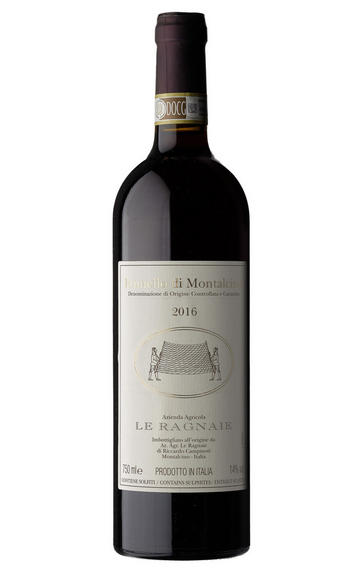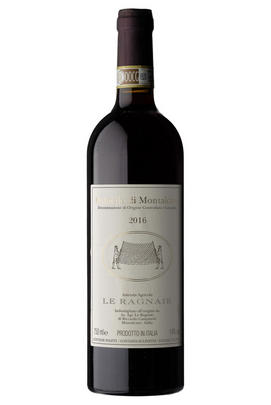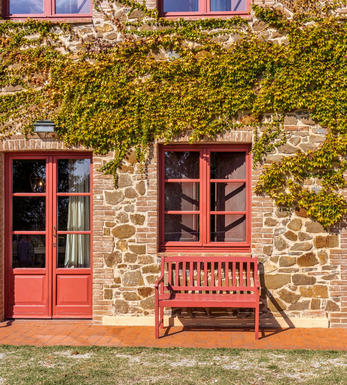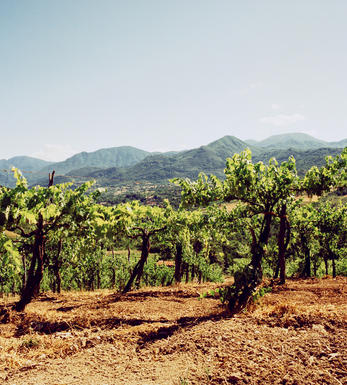
2016 Brunello di Montalcino, Le Ragnaie, Tuscany, Italy

Critics reviews
Drink 2023 - 2038
Monica Larner, Wine Advocate (Nov 2020)
A firm, linear style, featuring black cherry, black currant, licorice, iron and spice aromas and flavors. Though firmly structured and compact, there's an energy here and an overall balance that makes this red compelling. Ends with a terrific finish, evoking fruit, spice and underbrush accents. Best from 2025 through 2048.
Bruce Sanderson, Wine Spectator (April 2021)
James Suckling, jamessuckloing.com (Jul 2021)
Drink 2023 - 2035
Michaela Morris, Decanter.com (Mar 2021)
Drink 2024 - 2036
Eric Guido, vinous.com (Nov 2020)
About this WINE

Azienda Agricola Le Ragnaie
Le Ragnaie is a relative newcomer to the region. It was established by husband and wife Riccardo and Jennifer Campinoti in 2002, when they bought a small podere that had made wine on a small scale since 1991. From 2006 they started to add carefully selected plots of vines across three distinctly different zones of Montalcino.
Le Ragnaie itself is in the centre of the region at its highest point, lying at close to 550m above sea level. Vineyards here are south-facing. Petroso is one of the oldest wine-making zones lying below Montalcino village, and Castelnuovo dell’Abate lies even further south, facing Monte Amiata guarding the south-eastern border of the region. In 2015 a new vineyard was added to their collection, this time to the north of the town of Montalcino, in the famed and highly sought-after vineyard of Montosoli, now officially recognised as a single cru. Their vineyards are managed organically.
Today the estate covers 15 hectares of vines, and with such diverse terroirs the estate has chosen to follow a philosophy of allowing each plot to express its own individual identity. Six Brunelli are produced, one a blend combining fruit from all four distinct zones, with five others each the fruit of a single cru. All are traditionally made, with fermentation and extended maceration in concrete vats, followed by ageing for 36 months in large Slavonian oak casks.
Riccardo’s gentle approach to winemaking, inspired by his love of Burgundy, gives their wines a charm and accessibility that belies their subtle power, allied to a vitality, freshness and precision born of the fruit from some of the region’s highest and coolest vineyards.
A property to watch… and follow!

Brunello di Montalcino
Along with Chianti, Brunello di Montalcino is Tuscany's most famous DOCG and the region's boldest expression of Sangiovese. Located 30 miles south of Siena with the hilltop town of Montalcino as its epicentre, its 2,000 hectares of vines are naturally delimited by the Orcia, Asso and Ombrone valleys. Brunello is the local name for the Sangiovese Grosso clone from which Brunello di Montalcino should be made in purezza (ie 100 percent).
The Brunello di Montalcino DOCG has a whale-like shape: at its head, at 661 metres above sea level on ancient, stony galestro soils facing east and southeast lies the town of Montalcino, where the DOC was founded. As you follow the spine south towards the tail, the vineyards lose altitude – those around Colle Sant'Angelo are at 250 metres – while the soils become richer with iron and clay. Further east, in the shadow of the 1,734 metre Mont'Amiata lies the village of Castelnuovo dell'Abate where the vineyards are strewn with a rich mix of galestro, granitic, volcanic, clay and schist soil types.
Historically, the zone is one of Tuscany's youngest. First praised in 1550 by Leandro Alberti for the quality of its wines, it was Tenuta Il Greppo who bottled the inaugural Brunello di Montalcino in 1888. By 1929, the region had 925 hectares of vines and 1,243 hectares of mixed crops, while in 1932 it was decreed that only those wines made and bottled within the commune could be labelled as Brunello di Montalcino. Since then, the number of producers has risen from 11 in 1960 to 230 in 2006, while over the same period the vineyards have expanded from 1,000 hectares to 12,000. The region earned its DOC in 1966, and was upgraded to DOCG in 1980.
Brunello di Montalcino cannot be released for sale until five years after the harvest, or six years in the case of Brunello di Montalcino Riserva. During this time the wines should be aged for at least two years in oak, followed by at least four months in bottle (six months for Riservas); maximum yields are 55 hl/ha.
Rosso di Montalcino is declassified Brunello di Montalcino, released for sale 18 months after the harvest.
Recommended producers: Costanti, Fuligni, Lisini, San Giuseppe, Soldera, Cerbaiona

Sangiovese
A black grape widely grown in Central Italy and the main component of Chianti and Vino Nobile di Montepulciano as well as being the sole permitted grape for the famed Brunello di Montalcino.
It is a high yielding, late ripening grape that performs best on well-drained calcareous soils on south-facing hillsides. For years it was blighted by poor clonal selection and massive overcropping - however since the 1980s the quality of Sangiovese-based wines has rocketed upwards and they are now some of the most sought after in the world.
It produces wines with pronounced tannins and acidity, though not always with great depth of colour, and its character can vary from farmyard/leather nuances through to essence of red cherries and plums. In the 1960s the advent of Super Tuscans saw bottlings of 100% Sangiovese wines, as well as the introduction of Sangiovese/Cabernet Sauvignon blends, the most famous being Tignanello.


Buying options
Add to wishlist
Description
The only new releases from Le Ragnaie fitted with a white label instead of a black one, the 2016 Brunello di Montalcino is the most accessible and near-term in the portfolio. This is a very elegant and perfumed expression of Sangiovese with lifted floral aromas that recall blue flower and wild rose. Beyond those delicate tones, you get cherry, cassis and other classic aromas linked to Sangiovese. This wine draws on a blend of fruit from various vineyard sites with high and low elevations. Production is 27,700 bottles.
Drink 2023 - 2038
Monica Larner, Wine Advocate (Nov 2020)
wine at a glance
Delivery and quality guarantee